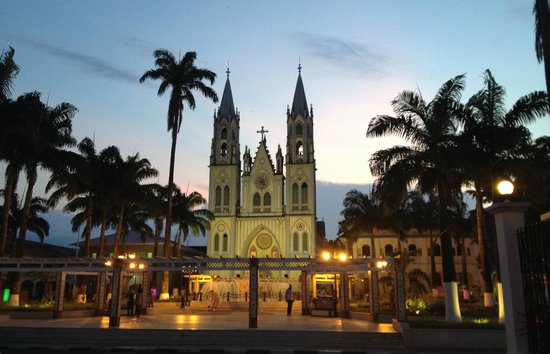
Travel on a low budget and Guinea Ecuatorial travel attractions for all travelers
Top travel locations to visit? A whole island all on its own, set out in the swells of the Atlantic Ocean, past the off-the-beaten-track isles of little-known Sao Tome, and directly in line with the coast of Gabon, the province of Annobon is hardly what you’d call easy to get to. It’s certainly got an interesting character though, with a history of Portuguese and Spanish colonialism, and the creole-flavoured beachside capital of San Antonio de Pale, to explore. Wildlife lovers will also find plenty to shout about, as pods of humpback whales languish in the swells around the island, rare Ojo Blanco birds hum on the cliffs, and baobabs hide lizards in the backcountry.
The little speck of Corisco Island can be found patrolling the entrance to Corisco Bay and the estuaries of Rio Muni just a stone’s throw from the coast of Equatorial Guinea. And while the untrodden beaches and swaying grasses of the sand dunes here are pretty to say the least, it’s the history and culture that really draw the crowds (even though those crowds are relatively small!). Yep, not only is there a series of crumbling Spanish missions to be found amidst the inland jungles, but there’s also been evidence of human habitation in these parts since the early Iron Age!
Chimpanzees swing and gorillas galumph through the wild, mist-topped backcountry; hoots and howls echo amidst the largely untrodden heights of the great Monte Alén peaks. Meanwhile, elephants hurtle through the dense forests of Altos de Nsork, primeval woods tick over along the Cameroonian and Gabon borderlands, gushing waterfalls flow, and the sylvan hills hide giant toads and otherworldly amphibians the likes of which you’ve never seen. Then, in the west, the old tribal lands of the Fang give way to the place of the beach people. Explore a few more info on this site.
For our spanish readers :
Ah, las vastas áreas silvestres del Parque Nacional Monte Alén: quizás el área más importante de belleza natural excepcional en África occidental de la que nunca has oído hablar. Y aunque las selvas húmedas y los cursos de agua del río Uoro siguen siendo una opción fuera de lo común, los que vienen están cosechando las recompensas: senderos de trekking vacíos; paquetes de safari personales y una experiencia incontaminada de la selva africana: ¡solo tres aspectos que me vienen a la mente! Aquí hay kilómetros y kilómetros de senderos mantenidos, junto con más vida salvaje de la que puedes sacudir en un plato de pollo ecuatorial con mantequilla de maní. Piensa en ranas goliath, gorilas, elefantes, cocodrilos y chimpancés súper raros …
Transformando lentamente a partir de un mosaico de zanjas de cimientos y sitios de construcción arenosos y comenzando a abrirse camino por encima de las verdes franjas de selva que dominan el interior de la provincia de Wele-Nzas, en el corazón de Guinea Ecuatorial, la ciudad de Djibloho sigue siendo solo un embrión de Lo que está planeado. También llamada Oyala, esta ciudad perfectamente organizada de redes entrecruzadas y centros de conferencias completamente nuevos está pensada como la futura capital de la nación. Una vez completado, aspirará a defender una relación simbiótica entre la vida moderna y el entorno natural y el patrimonio del país.
Por último, pero no menos importante, viene el pequeño Utonde en la costa atlántica. Con fácil acceso a las pistas de aterrizaje del aeropuerto de Bata y largos tramos de arena blanca en gran parte sin desarrollar a lo largo de su borde, no sorprende que sea aquí donde se están desarrollando algunos de los proyectos de desarrollo turístico más ambiciosos de Guinea Ecuatorial. Se planean mega resorts, con piscinas infinitas y frentes de playa privados, mientras que también hay conexiones con los extensos 330 kilómetros cuadrados de tierra que es la Reserva de Río Campo, que se extiende sobre las aldeas tribales Fang y los humedales cerca de la frontera con Camerún al norte. Descubrir extra detalles en Billetes de avión Cronosair.